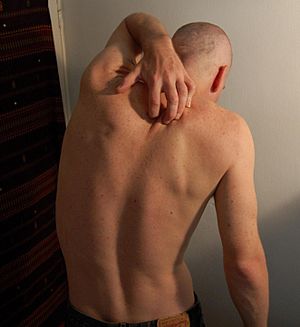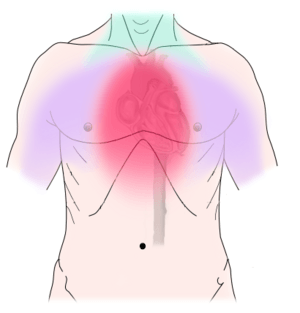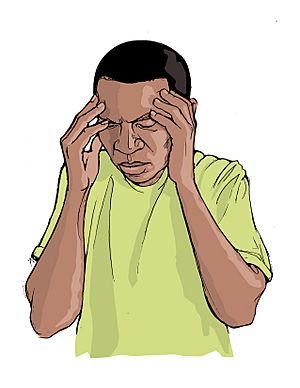Anaphylaxis facts for kids
Quick facts for kids Anaphylaxis |
|
|---|---|
 |
|
| Signs and symptoms of anaphylaxis | |
| Symptoms | Itchy rash, throat swelling, shortness of breath, light headed |
| Usual onset | Over minutes to hours |
| Causes | Insect bites, foods, medications |
| Diagnostic method | Based on symptoms |
| Similar conditions | Allergic reaction, angioedema, asthma exacerbation, carcinoid syndrome |
| Treatment | Epinephrine, intravenous fluids |
| Frequency | 0.05–2% |
Anaphylaxis is a very serious allergic reaction. It can start quickly and might even be life-threatening. It causes many symptoms like an itchy rash, a swollen throat, trouble breathing, and low blood pressure. Things like insect bites, certain foods, and medicines often cause it.
Anaphylaxis happens when your body reacts strongly to something you're allergic to. This 'something' is called an allergen. Your immune system overreacts. It releases special proteins from certain white blood cells. These proteins can start or worsen an allergic reaction.
Doctors diagnose anaphylaxis based on a person’s signs and symptoms. The best treatment is an injection (a shot) of epinephrine (also known as adrenaline). Sometimes doctors give other medicines along with epinephrine.
Allergy testing can help find out what caused a person’s anaphylaxis. Skin allergy tests, like patch tests, can check for allergies to certain foods or insect venoms. Blood tests can find allergies to milk, eggs, peanuts, tree nuts, and fish.
Around the world, about 0.05% to 2% of people experience anaphylaxis at some point. It seems to be becoming more common.
Contents
What is Anaphylaxis?
The word "anaphylaxis" comes from Greek words. "Ana" means against, and "phylaxis" means protection. So, it means "against protection."
Scientists have known about cases similar to anaphylaxis since ancient times. A scientist named Charles Richet first named the condition "aphylaxis" in 1902. Later, it was changed to "anaphylaxis." In 1913, Richet won the Nobel Prize in Medicine and Physiology for his important work on anaphylaxis.
Signs and Symptoms
Anaphylaxis can cause many different signs and symptoms. These can appear within minutes or a few hours. If the reaction is caused by something that went directly into the bloodstream (like an injection), symptoms usually show up in about 5 to 30 minutes. If it's caused by food, symptoms might take about 2 hours to appear.
Anaphylaxis usually affects two or more of these body systems:
- Skin
- Lungs and breathing pathways
- Stomach and intestines
- Heart and blood vessels
- Central nervous system
Skin Symptoms
Skin symptoms are very common and often include:
- Hives (raised, itchy bumps on the skin)
- General itchiness
- Flushing (when your face or skin turns red)
- Swollen lips
- A runny nose
- Swelling around the eyes and eyelids
- Angioedema (swelling under the skin). People with angioedema might feel a burning sensation instead of itching.
Sometimes, the tongue or throat can swell up. This happens in about 20% of cases and can make it very hard to breathe. If a person has trouble breathing, their skin might turn blue. This is called cyanosis and means the body is not getting enough oxygen.
Breathing Symptoms
Breathing problems are serious signs of anaphylaxis. They include:
- Trouble breathing, also called dyspnea or shortness of breath
- Bronchi (the tubes that carry air to the lungs) getting narrower. This is called bronchoconstriction and makes it harder for air to reach the lungs.
- Hoarseness, pain when swallowing, or a cough
When a doctor listens to the patient's lungs with a stethoscope, they might hear:
- Low-pitched sounds called wheezes. These are caused by the bronchi getting narrower.
- High-pitched sounds called stridor. These are caused by swelling in the upper airway.
Heart and Blood Symptoms
During anaphylaxis, some cells in the heart can release histamine. This can make the heart’s blood vessels suddenly get narrower. If the heart's blood vessels become too narrow, the heart might not get enough blood. This can lead to serious problems like:
- Heart cells dying. This is called a myocardial infarction, or a heart attack.
- The heart beating too slowly (Bradycardia) or too quickly (Tachycardia).
- The heart stopping completely. This is called cardiac arrest.
Anaphylaxis can also cause low blood pressure. This might happen because blood vessels get much wider due to chemicals released by the immune system. It can also be caused by cardiogenic shock, which means the heart isn't pumping enough blood to the rest of the body.
Other Symptoms
Stomach and gut symptoms can include painful abdominal pain, diarrhea, and vomiting. Some people might feel confused, lose bladder control, or have pelvic pain similar to uterine cramps. When blood vessels around the brain widen, it can cause headaches. People might also feel very anxious or have a feeling of "impending doom."
How Anaphylaxis is Treated
Anaphylaxis is a medical emergency that needs immediate emergency medical treatment. Some patients need help keeping their airways open so they can breathe. Others might need extra oxygen or large amounts of intravenous fluids (fluids given through a needle into a vein).
Epinephrine is the best treatment for anaphylaxis. Doctors often give antihistamines (which block histamine) and steroids along with epinephrine. After a person feels better, they should be watched in the hospital for 2 to 24 hours. This is to make sure their symptoms don't return.
Epinephrine is the most important and first treatment for anaphylaxis. It helps reverse many of the symptoms. For example, it makes the bronchi (air passages to the lungs) wider. It also helps blood vessels return to their normal size and raises blood pressure.
Epinephrine often comes in an "auto-injector," commonly called an "EpiPen." After taking off its safety cap, you just press the EpiPen into the thigh. The correct amount of epinephrine will automatically inject into the person's body. Doctors can prescribe EpiPens to people who know they have severe allergies. This way, they can treat themselves for anaphylaxis quickly.
Preventing Anaphylaxis
It is important to know how to prevent anaphylaxis if you have severe allergies. Here are some ways:
- Parents should tell schools about their children's allergies and what to do in an emergency.
- Knowing how and when to use EpiPens is crucial.
- Wearing a medical alert bracelet that states your allergies can be very helpful.
- Planning how to avoid things that trigger your allergies is important.
If anaphylaxis is diagnosed and treated quickly, there is a good chance of recovery. Even if no one knows what caused the reaction, the person usually recovers well as long as they get medication to stop the reaction.
Images for kids
See also
 In Spanish: Anafilaxia para niños
In Spanish: Anafilaxia para niños










